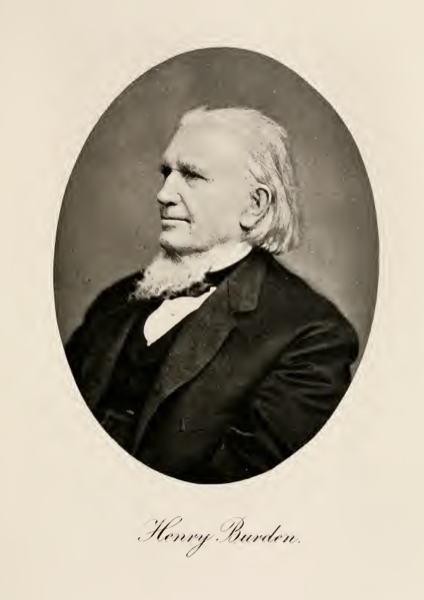
It’s baffling that Henry Burden isn’t better remembered around here. His inventions improved the iron industry, advanced mechanization and helped build the railroads. His use of hydropower on the Wynantskill was world famous. His massive iron and steel works in South Troy employed thousands when the collar industry was growing on the north end of town. But little remains of the works but the main offices (now a museum), and his beautiful church called Woodside (now an arts center). Even the replica of his famous water wheel is now gone, with the closing of the Riverspark center in Troy. But Henry Burden is worth remembering.
According to something resembling a biography put together by his daughter, Margaret Proudfit, Henry Burden was born at Dunblane, Scotland, April 22, 1791. The son of a farmer, he showed an early interest in inventing devices. He constructed a threshing machine, erected grist mils and built farm implements. Unlike the stories of many of our self-made immigrants, Burden sought out instruction, going to Edinburgh and taking courses in mathematics, engineering and drawing in order to advance his abilities. He came to the United States in 1819, working for Albany agricultural manufacturer Townsend and Corning. He invented what may have been the first cultivator in practical operation in the country, and patented a flax and hemp machine. In 1822, he moved up the river to Troy as agent and then superintendent of The Troy Iron and Nail Factory Company.
There was a time when nails were made by hand, scarce and expensive. Their automated manufacture was a huge leap forward. As railroads started to grow, spikes of uniform quality were an absolute necessity. Henry Burden anticipated a change in rail design and invented a countersink hook-headed spike for T or H shaped rails (early rails were just thin straps of steel), and the machine for making them. His first contract with the Long Island Railroad Company, in 1836, ensured the success of the spike and its future use. He also set legal precedent, after a battle against the Corning iron empire for its infringement on his patent was found in Mr. Burden’s favor after nearly 20 years of wrangling. “If anywhere machine hook-headed spikes have been found, it is certain that they have been made at the works of the Burden’s, or in contempt of a decision of the United States Supreme Court.”
He also patented the first really successful machine for the manufacture of horseshoes in 1834, which he continuously improved over two decades. “In 1857 he perfected and patented his present machine, which devours the heated bar, cuts, bends, and forges it into perfect shape with one movement, at the rate of sixty a minute, or thirty-six hundred shoes per hour.” His machines were the primary supplier of horseshoes for the Union Army, putting the rebels at a serious disadvantage, not having a mass manufacturer to supply their cavalry.
“The rebel government employed a man by the name of Moses, a co-operator with Saunders, Thompson, and others of that class to come to the North, steal the pattern of this horseshoe machine and smuggle it into Canada, with a view to the ultimate establishment of a horseshoe factory at Atlanta for the benefit of the rebel confederacy. As it happened, Sherman’s operations spoiled that game.”
Almost forgotten is his very important improvement in the manufacture of wrought iron, known as the “rotary squeezer.” Previously, great hammers were used to manipulate the metal between the puddling furnace and the rollers, creating what was called a bloom – essentially a blob of metal ready to be shaped. In many factories, this was a very manual process, employing “bloomers” who stood over molten metal and banged it into a suitable shape for the rolling mill. Henry Burden invented the rotary concentric squeezer, which created the same effect with minimal labor. “Go where you will in this country, in Great Britain, or on the Continent, you find Burden’s rotary squeezer.”
Burden dabbled in the improvement of steamboats, as well: “As early as 1825 he laid before the Troy Steamboat Association certain original plans whereby the construction of steamboats for inland navigation could be greatly improved, and which some years later were adopted in the building of the steamboat ‘Hendrick Hudson.’ Besides increasing the length of the boats, he wisely suggested for the convenience and accommodation of passengers, the erection of sleeping berth-rooms, on the upper decks, being a decided change from the holds of vessels where they had been previously placed.” He even proposed to create “Burden’s Atlantic Steam-Ferry Company,” a cross-Atlantic venture that never came to fruition.
Today, all this is perhaps overshadowed by the memory of his fabulous water-wheel, the second-largest but certainly the most powerful in the world, “the Niagara of water-wheels.” Long-gone, its location barely noted, it is nevertheless part of Troy’s heritage, well-remembered and well-loved.
Want to know more about Henry Burden? Just follow these links:
